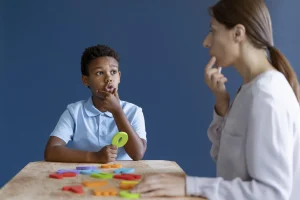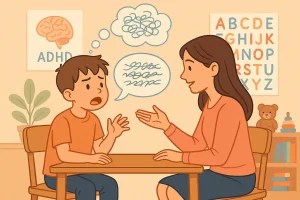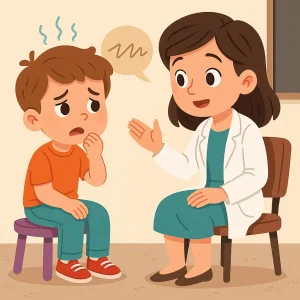10 Easy Ways to Teach Social Skills to Kids at Home
Last Updated: March 1, 2025
Welcome to our quick guide on “10 Easy Ways to Teach Social Skills to Kids at Home.” Good social skills are key to your child’s development, affecting everything from friendships to teamwork. This guide offers practical and enjoyable activities that seamlessly integrate into daily life, making learning both fun and impactful. Dive in as we explore effective ways to boost your child’s social interactions at home, ensuring they gain the essential skills needed for successful personal interactions.
Why Social Skills Matter for Kids
Social skills are more than just manners; they are the toolkit children use to interact with the world around them. Good social skills can significantly influence a child’s development, affecting everything from their ability to make friends to their performance in school.
Children who are adept at navigating social situations tend to be more confident and experience less anxiety when faced with new challenges. These skills lay the groundwork for collaborative tasks and problem-solving—key components in both academic and future workplace environments. By engaging in social skills activities for kids, parents can provide their children with the necessary experiences to develop empathy, understanding, and respect for others’ perspectives.
Setting the Right Environment at Home
Creating a nurturing environment at home is crucial for teaching your child valuable social skills. A positive and supportive atmosphere not only makes learning more effective but also more enjoyable. Here are some tips on how to craft the perfect setting using home-based social learning techniques that can help your child thrive socially.
- Designate a Social Learning Space:
Set aside a specific area in your home where social learning activities can take place. This could be a corner of the living room or part of your child’s playroom. Make sure it’s stocked with materials that encourage interaction, like board games, puppets, and role-play costumes. - Model Positive Interactions:
Children learn a lot by watching adults. Show them how to interact positively with others through your everyday actions and conversations. Use polite language, demonstrate good listening skills, and show empathy in your interactions with family and friends. - Encourage Open Communication:
Make your home a safe space for expressing feelings and opinions. Encourage your child to speak openly about their emotions and thoughts, and make sure to listen actively and validate their feelings. This practice helps children feel understood and teaches them how to express themselves constructively. - Set Clear Expectations and Rules:
Clearly communicate the social rules and expectations in your home. Discuss why these rules are important and how they help everyone get along better. For instance, taking turns while speaking, sharing toys during playtime, or helping set the table for meals can be great starting points. - Regularly Schedule Social Activities:
Plan regular activities that require social interaction, whether it’s playdates with friends or family game nights. These activities give children a chance to practice their social skills in a controlled and familiar environment.
Way 1: Role-Playing Games
Role-playing games are a fantastic tool for teaching children how to navigate various social scenarios. By stepping into someone else’s shoes, kids can learn empathy, problem-solving, and communication skills in a fun, engaging way. Here’s how you can use role-playing games effectively at home:
- Create Scenarios Together: Start by discussing different social situations with your child—these could be as simple as asking for a toy or as complex as resolving a conflict. Together, come up with different outcomes and ways to handle each situation.
- Use Props and Costumes: Enhance the role-playing experience by using props, costumes, or toys that are relevant to the scenario. This makes the play more realistic and immersive, helping your child better understand the emotions and actions involved.
- Switch Roles Frequently: Encourage your child to play different roles. This helps them understand various perspectives and the importance of empathy in social interactions.
- Debrief After Playing: Post role-play, have a chat with your child about what they learned from the experience. Ask questions like, “How do you think the other person felt?” or “What would you do differently next time?”
Way 2: Emotional Expression Activities
Teaching kids to express their emotions appropriately is crucial for their emotional intelligence and social interactions. Here are some engaging activities that can help:
- Emotion Matching Games: Create cards with different facial expressions or scenarios and have your child match them to the appropriate emotions. This helps them recognize and name their feelings accurately.
- Feeling Charades: Play a game of charades where instead of movies or books, the themes are different emotions. This activity encourages children to express feelings through facial expressions and body language.
- Create a ‘Feelings Journal’: Encourage your child to keep a journal where they can draw or write about their feelings each day. This not only helps in expressing emotions but also in understanding them better over time.
- Story Time with Emotions: Read stories together and discuss the characters’ emotions and reactions. Ask your child how they might feel in a similar situation, which promotes empathy and emotional understanding.
Way 3: Practicing Manners and Greetings
Teaching manners and proper greetings is a fundamental aspect of social skills that helps children interact confidently and respectfully. Here are some simple exercises to enhance your child’s communication skills:
- Role-Playing Different Scenarios: Practice various greeting scenarios with your child, such as meeting someone new, greeting a friend at school, or saying thank you when given a gift. This helps them understand the appropriate ways to interact in different social settings.
- Greeting of the Day: Have a new greeting for each day of the week, such as a handshake on Monday, a wave on Tuesday, and so on. This not only makes learning fun but also introduces your child to various forms of acknowledging others.
- Manners Reward Chart: Create a chart that tracks manners and polite behavior. Each time your child uses a polite greeting or manner, they get a sticker. This positive reinforcement encourages consistent effort.
- Dinner Table Practice: Use family meal times as a practice ground for polite conversation, teaching them how to ask for things nicely, how to compliment the food, and how to thank the cook.
Way 4: Sharing and Cooperation Tasks
Effective sharing and cooperation are crucial for building social skills in children. Here’s how you can encourage these behaviors through fun activities:
- Team Building Games: Engage your child in games that require teamwork, such as building a puzzle together or playing a cooperative board game. These activities teach the value of working together and supporting each other.
- Sharing Circle Time: Have a ‘sharing time’ where each family member shares something, whether it’s a toy, a story, or a snack. This ritual not only promotes sharing but also shows its benefits, like making others happy and making friends.
- Role-Swap Tasks: Assign household chores that require your child to cooperate with others. This could involve setting up the table with a sibling or organizing the playroom together. Discuss how cooperating can make the tasks more enjoyable and quicker to complete.
Way 5: Understanding and Respecting Boundaries
Respecting personal space and boundaries is essential for healthy social interactions. Here are some activities that can help children learn about and respect boundaries:
- Personal Space Circle: Teach your child about personal space by using a hula hoop or a rope to create a ‘space bubble.’ Explain that everyone has their own bubble that needs to be respected.
- Boundary Setting Practice: Have discussions about what types of physical contact are okay and when it’s important to ask for permission. Role-play situations where they might need to assert their boundaries or respect someone else’s.
- Scenario-Based Discussions: Use storybooks or shows to point out scenarios involving boundary issues. Pause and ask your child how they would handle the situation, discussing the importance of respecting others’ space and boundaries.
- Recognize Feelings Game: Create a game where your child identifies how different interactions make them feel. Use facial expressions, body language, and verbal cues to help them understand and respect how their actions affect others.
Way 6: Turn-Taking Games
Turn-taking is a fundamental skill in social interactions, promoting patience and fairness among children. Through turn-taking games, children learn to wait for their turn and respect others’ opportunities to participate. Here are some effective ways to reinforce this skill at home:
- Board Games: Classic games like ‘Snakes and Ladders’ or ‘Uno’ naturally enforce turn-taking and can teach children the patience required to wait for their turn while enjoying the excitement of the game.
- Story Building: Engage in a group storytelling activity where each family member adds a sentence to the story in turn. This not only fosters creativity but also patience as each participant waits for their turn to contribute.
- Cooking Together: Involve your child in cooking activities where turn-taking is required, such as adding ingredients to a mix. This shows them how waiting their turn can lead to a successful outcome in everyday tasks.
- Musical Games: Play musical games such as ‘Hot Potato,’ where children pass an object around in a circle until the music stops. This game is great for teaching quick response times and the anticipation of waiting for one’s turn.
Way 7: Problem-Solving Together
Problem-solving is an essential cooperative skill that enhances a child’s ability to interact positively and constructively with others. Engaging in problem-solving activities at home can significantly improve your child’s social interactions by teaching them to work through conflicts and challenges cooperatively. Here’s how you can incorporate problem-solving into your daily routine:
- Puzzle Solving: Encourage your child to solve puzzles that require more than one person to complete. This could be a physical puzzle or a digital problem-solving game that you can work on together.
- Role-Play Conflict Scenarios: Create scenarios where your child has to resolve a conflict with a friend or a sibling. Guide them through the discussion process, emphasizing listening to the other person’s viewpoint and finding a middle ground.
- Treasure Hunts: Organize treasure hunts that require solving clues or riddles together. This activity requires participants to discuss and decide the best course of action, enhancing cooperative problem-solving skills.
- DIY Projects: Engage in a DIY project where you and your child must figure out how to build or fix something. This real-life application of problem-solving can be incredibly rewarding and educational.
Way 8: Observing and Discussing Social Situations
Teaching social skills can be as simple as observing and discussing daily interactions around you. Parents play a crucial role in helping their children understand and interpret social cues through real-life examples. Here’s how you can make the most out of everyday situations:
- Discuss Observations: After attending social events or gatherings, discuss what you and your child observed. Talk about body language, facial expressions, and how people reacted to different situations.
- Role-Model Commentary: When watching TV shows or movies together, pause to discuss the social interactions between characters. Ask questions like, “Why do you think she reacted that way?” or “What would you do in his place?”
- Praise Positive Interactions: When you see your child interacting well with others, provide positive feedback. Discuss what they did well and why it was effective in that social situation.
- Learn from Mistakes: If a social interaction doesn’t go as expected, use it as a learning opportunity. Discuss what might have been done differently and how to improve in the future.
Way 9: Using Technology Wisely
In today’s digital age, technology can be a valuable tool in reinforcing social skills learning at home. Here are some recommended apps and online resources that can help enhance your child’s social development:
- Social Skills Apps: Apps like ‘Model Me Going Places’ or ‘The Social Express’ provide interactive social skills training through engaging scenarios and simulations.
- Educational Videos: Platforms like YouTube have channels dedicated to social skills, offering videos that teach children about empathy, sharing, and communication.
- Online Games: Look for games that encourage cooperation and teamwork. Games like ‘Poptropica’ and ‘Club Penguin’ can offer safe, moderated environments for practicing social interactions.
- Virtual Reality: Some newer technologies offer virtual reality experiences that simulate social situations for practice, which can be particularly useful for visual and experiential learners.
Way 10: Encouraging Participation in Group Activities
Group activities are excellent for teaching teamwork, empathy, and negotiation skills. Here’s how you can encourage your child to actively participate in group settings:
- Choose the Right Activities: Pick group activities that align with your child’s interests. Whether it’s sports, music, or a drama club, engaging in preferred activities can motivate your child to interact more with peers.
- Role-play Group Scenarios: Before a group activity, role-play potential social scenarios with your child. This can help them feel more prepared and confident.
- Facilitate but Don’t Dominate: When your child is engaged in a group activity, be supportive but allow them the space to navigate their own social interactions. This encourages independence and problem-solving.
- Encourage Reflective Discussions: After group activities, discuss what your child enjoyed and what challenges they faced. This reflection helps reinforce lessons learned and prepares them for future interactions.
Conclusion
Teaching social skills at home is crucial for your child’s growth and future success. Each strategy we’ve discussed helps them interact confidently and build lasting relationships. Remember, patience and consistency are key. Integrate these lessons into daily life and watch your child’s social abilities flourish. For more resources and support, visit Wellness Hub. Together, let’s empower your child to navigate social situations with ease and confidence. Celebrate their progress and enjoy this journey of development with them!
Frequently Asked Questions:
1. What are some simple activities to teach social skills to kids?
Engage your kids with role-playing different social situations, cooperative games like board games, and sharing exercises to help them learn important social behaviors in a fun and engaging way.
2. How can I help my child improve their communication skills?
Practice everyday interactions with your child, like saying hello or thank you, encourage them to express their feelings, and discuss the emotions of characters in stories to enhance their ability to communicate effectively.
3. What games can help my child learn patience and sharing?
Games that require taking turns like ‘Snakes and Ladders,’ and activities that involve teamwork, such as building a puzzle together, are excellent for teaching patience and the value of sharing.
4. Why is it important for children to learn social skills at an early age?
Early development of social skills sets the foundation for better interpersonal relationships and academic success, helping children navigate social settings with confidence and ease.
5. How can technology be used to teach social skills to children?
Utilize apps and online games that simulate social scenarios or offer problem-solving activities, which can provide interactive and engaging ways for children to learn social cues and behaviors.
6. What are the benefits of group activities for children’s social development?
Participating in group activities helps children understand team dynamics, learn conflict resolution, and develop empathy, which are crucial for their growth and future interactions.
7. How can I teach my child to respect others’ personal space and boundaries?
Teach your child about personal space through games that use physical boundaries and have open discussions about respecting others’ feelings and personal space, emphasizing the importance of consent.
8. What should I do if my child struggles with social interactions?
Keep encouraging them by practicing social skills at home, provide positive reinforcement, and seek guidance from child development experts if you observe ongoing difficulties.
9. Can you suggest any effective problem-solving activities for kids?
Encourage your child to engage in activities like solving puzzles, organizing treasure hunts that require following clues, and participating in simple projects that require figuring out how to use various items to achieve a goal.
10. How can observing and discussing social situations help my child?
By observing real-life interactions or discussing hypothetical situations, children can learn how to read social cues and react appropriately, which aids in their understanding of social norms and expectations.
About the Author:
Shravanaveena Gajula
M.Sc ., Speech and Language Pathology (5+ years of experience)
Shravanaveena Gajula is a dedicated Audiologist and Speech-Language Pathologist with a BASLP and an M.Sc in Speech and Language Pathology. With experience spanning multiple settings, including Wellness Hub and Ashray Akruti, Veena specializes in a wide range of disorders from developmental issues in children to speech and language assessments in adults. Her expertise includes parent counseling, managing speech sound and fluency disorders, and creating individualized therapy programs. Veena is also PROMPT certified and an author of several insightful blogs on speech and language pathology, aiming to educate and assist caregivers in supporting their loved ones.
Book your Free Consultation Today
Parent/Caregiver Info:
Client’s Details:
* Error Message








